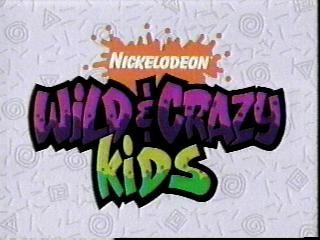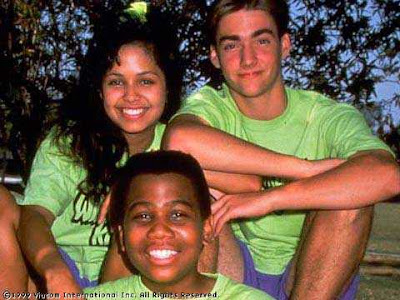
Sometimes you're watching a show and you can almost imagine what the network producers were thinking when they conceived of the inane idea. In the case of Wild and Crazy kids, I'm willing to venture that they were thinking, "What would be the easiest program to produce with universal appeal to children that costs us next to nothing?" The idea was marginally brilliant. A game show-esque format with a messiness factor guaranteed to lure in young viewers while concurrently forgoing any sort of prize or reward for the victors. It was more or less a case of take-everything-in-the-Nickelodeon-back-room-and-office-fridge-leftovers, arrange them haphazardly in a field, release a slew of cheaply t-shirted children, and let the games begin.
Wild and Crazy Kids seems like one of those one-in-the-morning ideas, the sort of which were particularly common to Nickelodeon during the 1990s. They simply planned some inconsequential events that were simultaneously sloppy and required little to no innate skill, handed out some t-shirts, and then completely snub the winners by offering no tangible goods in the means of congratulations. In days of consolatory Carmen Sandiego Gumshoe prize packs and all-expenses paid trips to Universal Studios, this was in somewhat bad form.They could have at least sent the winners packing with a Gak pack.
Luckily, the show was not particularly self-referential or self-examing. It never once alluded to the fact that hordes of children were covered in chocolate pudding and shaving cream with no foreseeable purpose or aim. It was, simply put, a chance for kids to be both Wild and Crazy. Oh, and they also got a free t-shirt, though inevitably they left the show with their trademark shirts covered in slime or pie.
Nickelodeon in the 90s was huge on slime and pie. There's no real discernible evidence as to why these were the prevailing super sloppy weapons of choice, but we just accepted that any misstep would lead to someone being doused in green slime or cream pied in the face. It was just sort of a given. Miss the baton pass in a relay? Slime and pie. Strike out at Dizzy Bat Home Run Derby? Slime and pie. Wipe out slip n' sliding? Well, you get the idea.
Each half-hour show featured three games of relatively equal insanity and inanity. The games usually went a little something like this:
As you can see, the production values on these shows were somewhat less than cinematic. The show looked more like a home movie of kids doing relay races at a school picnic than an actual show airing on a reputable children's network. As I said, it obviously wasn't costing them the big bucks, unless we're seriously underestimating the cost of spaghetti and tarps here.
Wild and Crazy Kids had three young hosts, with Omar Gooding and Donnie Jeffcoat emceeing both seasons and Annette Chavez and Jessica Gaynes each putting in one season. The hosts usually put on some sort of skit or teaser at the beginning of each show, which I once found hilarious but now believe to be potentially a bit grating. They also provided the commentary, taking very seriously elements like instant replays and play-by-plays. This sounds much more serious until you realize they were instantly replaying ketchup and mustard jousting.
The show was not without its gimmicks. They indulged in the occasional cheap cross-over inter-show challenge, such as in this episode with Marc Summers of Double Dare fame. Since the shows had a lot of shared underlying themes (read: slime and pie), it was not quite a stretch to envision the union of their Physical Challenge courses.
They also had a prime opportunity to hawk their very own Nickelodeon products, such as the oft-coveted Moon Shoes. After all, what's a cheaply produced aimless game show without a product placement thrown in now and again?
These guys were also sort of partial to making people spin around on a bat for dizzying impact. For some reason, all of these wild and/or crazy stunts seemed at least somewhat more humorous when the element of nausea and vertigo were in the picture. I doubt I'd make it through this segment without a Dramamine or one of those sea-band bracelets*.
Wild and Crazy Kids played it to the point. There was no moral of the story nor was there any remote educational value. The kids did not come away better people** by popping shaving cream-filled balloons while wearing moon-shoes. It was pure, guilty fun that never made any subtle attempt to market itself as anything other than just that. It may not have been the most affective shows of its time, but it's certainly a contender for one of the messiest***.
*I do not official endorse these products, but they do keep me from vomiting while deep-sea fishing or on glass bottom boats. I imagine a similar effect would have been had as a Wild and Crazy kid **To my knowledge. If you participated as a contestant, feel free to contradict this allegation ***Did I mention the slime and pie?















